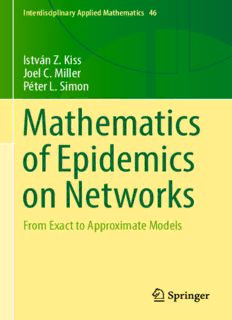Table Of ContentInterdisciplinary Applied Mathematics 46
István Z. Kiss
Joel C. Miller
Péter L. Simon
Mathematics
of Epidemics
on Networks
From Exact to Approximate Models
Mathematics of Epidemics on Networks
Interdisciplinary Applied Mathematics
Volume 46
Editors
S.S.Antman,UniversityofMaryland,CollegePark,MD,USA
[email protected]
L.Greengard,NewYorkUniversity,NewYork,NY,USA
[email protected]
P.J.Holmes,PrincetonUniversity,Princeton,NJ,USA
[email protected]
Advisors
R.Durrett,DukeUniversity,Durham,NC,USA
L.Glass,McGillUniversity,Montreal,QB,Canada
A.Goriely,UniversityofOxford,Oxford,UK
R.Kohn,NewYorkUniversity,NewYork,USA
P.S.Krishnaprasad,UniversityofMaryland,CollegePark,MD,USA
J.D.Murray,UniversityofOxford,Oxford,UK
C.Peskin,NewYorkUniversity,NewYork,USA
S.S.Sastry,UniversityofCalifornia,Berkeley,CA,USA
J.Sneyd,UniversityofAuckland,Auckland,NZ
Moreinformationaboutthisseriesathttp://www.springer.com/series/1390
Istva´n Z. Kiss • Joel C. Miller • Pe´ter L. Simon
Mathematics of Epidemics
on Networks
From Exact to Approximate Models
123
Istva´nZ.Kiss JoelC.Miller
DepartmentofMathematics AppliedMathematics
UniversityofSussex InstituteforDiseaseModeling
Falmer,Brighton,UK Bellevue,WA,USA
Pe´terL.Simon
InstituteofMathematics
Eo¨tvo¨sLora´ndUniversity
Budapest,Hungary
ISSN0939-6047 ISSN2196-9973 (electronic)
InterdisciplinaryAppliedMathematics
ISBN978-3-319-50804-7 ISBN978-3-319-50806-1 (eBook)
DOI10.1007/978-3-319-50806-1
LibraryofCongressControlNumber:2017931653
Mathematics Subject Classification (2010): 00A71, 00A72, 05C82, 34C11, 34C23, 34D20, 35Q84,
37G10, 37N25, 47D06, 47N40, 60J27, 60J28, 60J75, 60J80, 60J85, 60K20, 60K35, 82B43, 91D30,
92C42,92D30
©SpringerInternationalPublishingAG2017
Thisworkissubjecttocopyright.AllrightsarereservedbythePublisher,whetherthewholeorpartof
thematerialisconcerned,specificallytherightsoftranslation,reprinting,reuseofillustrations,recitation,
broadcasting,reproductiononmicrofilmsorinanyotherphysicalway,andtransmissionorinformation
storageandretrieval,electronicadaptation,computersoftware,orbysimilarordissimilarmethodology
nowknownorhereafterdeveloped.
Theuseofgeneraldescriptivenames,registerednames,trademarks,servicemarks,etc.inthispublication
doesnotimply,evenintheabsenceofaspecificstatement,thatsuchnamesareexemptfromtherelevant
protectivelawsandregulationsandthereforefreeforgeneraluse.
Thepublisher,theauthorsandtheeditorsaresafetoassumethattheadviceandinformationinthisbook
arebelievedtobetrueandaccurateatthedateofpublication.Neitherthepublishernortheauthorsor
theeditorsgiveawarranty,expressorimplied,withrespecttothematerialcontainedhereinorforany
errorsoromissionsthatmayhavebeenmade.Thepublisherremainsneutralwithregardtojurisdictional
claimsinpublishedmapsandinstitutionalaffiliations.
Printedonacid-freepaper
ThisSpringerimprintispublishedbySpringerNature
TheregisteredcompanyisSpringerInternationalPublishingAG
Theregisteredcompanyaddressis:Gewerbestrasse11,6330Cham,Switzerland
In authororder, wededicatethisbookto our
wives Katalin,Anja,andNadinka andour
childrenLouisa andε;Maaikeand
2
Jojanneke;and Nadinka,Zso´fia,Vikto´ria,
Bernadett,and Bru´no´.
Preface
Over the past decade, the use of networks has led to a new modelling paradigm
combiningseveralbranchesofscience,includingphysics,mathematics,biologyand
socialsciences. Thespreadof infectiousdiseasesbetweennodesin a networkhas
been a central topic of this growing field. The fundamental questions are easily
stated,butansweringthemdrawsonobservationsandtechniquesofmanyfields.
Thereisalongsuccessfulhistoryofmathematicalmodellinginformingpolicies
to mitigate the impact of infectious disease. Typically, models divide the popula-
tionintocompartmentsbasedoninfectionstatusandusesimpleassumptionsabout
mixingandmovementsbetweenthesecompartments.Overtime,thesemodelshave
grown more sophisticated to more accurately incorporate the contact structure of
thepopulationandtotakeadvantageofincreasedcomputationalresources.Forex-
ample,sexuallytransmitteddiseaseshavebeeninvestigatedusinghigh-dimensional
compartmentalmodelsseparatingindividualsbycontactrates,socio-economicsta-
tusandmanyotherfactors.However,whenwemaketheadditionalobservationthat
partnershipsmaybelong-lasting,anewparadigmisneeded,leadingnaturallytoa
networkrepresentationofthepopulationstructure.
Progressinmodeldevelopmenthasbeenextremelyfastandhasattractedinter-
estfroma diversesetof researchers.The fundamentalobjectiveis to combinethe
underlying population contact structure and the properties of the infectious agent
toyieldanunderstandingoftheresultingspectrumofepidemicbehaviours.Todo
this, researchers translate observed population and disease properties into a well-
definedmodel.Inmanycases,themodelsitsattheinterfaceofgraph/networkthe-
ory,stochasticprocessesandprobabilitytheory,dynamicalsystems,andstatistical
physics. The diversity of researcher backgrounds and the variety of applications
considered have led to the developmentof many different modelling approaches.
Asthefieldmatures,thereisaneedtoincreaseunderstandingofhowthesediffer-
entmodelsfit together,how theyrelate to the underlyingassumptionsandhow to
developanappropriatemathematicalframeworktounifydifferentapproaches.
vii
viii Preface
This booksets outto make a contributionto modellingepidemicson networks
bysynthesisingalargepoolofmodels,rangingfromexactandstochastictoapprox-
imatedifferentialequationmodels,sothatwemay:
1. recogniseunderlyingmodelassumptionsandtheresultingmodelcomplexity;
2. provideamathematicalframeworkwithwhichwecandescribeobservedphe-
nomenaandpredictfuturescenarios;
3. permitdirectcomparisonofthemainmodelsandprovidetheirhierarchy;and
4. identify research gaps and opportunities for further rigorous mathematical
exploration.
Chapter1introducesthereadertothefundamentalsofdiseasetransmissionmod-
elsandtheunderlyingnetworks.Chapter2takesarigorousprobabilisticviewand
frames disease transmission on a network as a continuous-time Markov chain. In
contrast, Chapter 3 builds a hierarchy of models starting at the node level which
depend on the node–neighbour pairs, which in turn depend on triples formed by
consideringthenext-nearestneighbours.Chapter4focusesonmean-fieldandpair-
wise models and their analysis on homogeneousnetworks. Chapter 5 extends ap-
proaches of Chapter 4 to heterogeneousnetworks and introduces effective degree
models. In Chapter 6, the focus is primarily on SIR epidemics, and percolation
theory methods are used to derive the low-dimensional edge-based compartmen-
talmodel.Chapter7 bringsthedifferentSIRmodelstogether,showingthatunder
reasonableassumptions,thehigh-dimensionalmodelsofearlierchaptersreduceto
the low-dimensionalmodel of Chapter 6. Chapter 8 extends the earlier models to
accountforthesimultaneousspreadofthediseaseandchangeinthenetwork,con-
sideringseveralscenariosforhownetworksvaryintime.Chapter9generalisesthe
pairwiseandedge-basedcompartmentalmodelstonon-Markovianepidemics,lead-
ing to integro-differentialand delay differentialequations. Chapter 10 starts from
a Markov chain to derive the Fokker–Planck equation for the distribution of the
numberof infected individualsas a functionof time and uses the resultingpartial
differentialequation (PDE) to investigateepidemic processes. Finally, Chapter 11
shows that our models can perform surprisingly well even in networks, including
empirically observed networks, for which the assumptions they are based on do
notappearto be satisfied. TheAppendixgivesefficientsimulationalgorithmsand
discussesissuesencounteredinsimulatingepidemicsonnetworks.
With more space, we would have liked to make a stronger emphasis on prob-
abilistic models. Moreover, we would have examined epidemic control measures
suchas vaccinationandcontacttracing,as wellashouseholdmodels.Manyother
topics,forexample,multilayernetworks(networkswithmultipletypesofconnec-
tions),areleftout,althoughmanyofthetechniqueswediscussapplytothem.An
additionaltopic,deservingofabookonitsown,wouldbetheuseofreal-worlddata
toparametrisenetworkmodels.
This book contains a number of rigorous mathematical arguments and proofs.
However, a guiding principle throughout is to appeal to and be useful for audi-
ences in fields outside of mathematics. Some quantitative sophistication will be
Preface ix
necessary; in particular, previous exposure to linear algebra, calculus, differential
equations, dynamical systems and basics of probability and stochastic processes
wouldbeuseful.Wedonotassumeknowledgeofgraphtheory.
Advancedundergraduateandgraduatestudentscanusethebookasafoundation
forlearningthemainmodellingandanalysistechniques.Therearemanyexercises
designedtodevelopadeeperunderstandingofthetopic.Modelsandresultsofim-
mediateapplicabilityaresignpostedthroughtheuseofgreyboxes.
Weusethisformattohighlightreadilyimplementablemodelsortosummarise
modeloutcomes,suchassteadystates,finalepidemicsize,basicreproductive
ratioR ,probabilityofanepidemic,etc.
0
Doctoralstudents,researchersandexpertsinthisareacanusethebooknotonly
as a reference guide or synthesis of the major modelling frameworks and model
analysis tools but also to (i) confirm the validity and optimal range of applicabil-
ity of models, (ii) understand how mathematical tools have been and are used in
networkmodellingand(iii)identifyfurthersynergiesbetweenmainstreammathe-
maticalmethodsandproblemsarisinginnetworkmodelling.
To enhancethe flow of the presentation,citationsto previousresearchare con-
centratedeitherat thebeginningor endofchapters.Thisallowsusto (a)build up
modelsfromthegroundupbyunifyingdifferentapproachesleadingtosynthesised
modelsand(b)citefurthernewdevelopmentsthatwecouldnotcover.
Pseudocode for efficient epidemic simulation algorithms is given in the
Appendix,andready-to-runsourcecodeisavailableatthefollowingwebsite:
https://springer-math.github.io/Mathematics-of-Epidemics-on-Networks/
These include stochastic simulation of SIS and SIR on networks and numerical
solutions of many differentialequation models we present in the book. An exten-
sivePythonpackageusingNetworkX[130]isprovided,andmanyofthesearealso
availablein Matlab.We hopeto addadditionallanguages.These willhelpreaders
tocompletemanyofthesimulation-basedexercisesproposedinthebookandmay
assist other researcherswith their own projects. Other resources are available; for
example, a useful package in C++ is EpiFire [143]. Solutions to exercises will be
madeavailableforinstructorswhousethebook.Inevitably,smallerrorscreepinto
anybook.Pleasecontactusdirectlyforsolutionsortoreporterrors.
Acknowledgements: The authors wish to thank their former and current co-
workers and collaborators, research students and their current and former insti-
tutions. IZ Kiss thanks the University of Leeds, the University of Oxford and
the University of Sussex; JC Miller thanks Pennsylvania State University (Penn
State), Monash University (in particular MAXIMA) and the Institute for Disease
Modeling and PL Simon thanks the Department of Applied Analysis and Com-
putational Mathematics and the whole Institute of Mathematics at the Eo¨tvo¨s
Lora´nd University in Budapest, Hungary. The community at tex.stackexchange.
com hashelped with intricaciesof LATEX. The authorsthank Dr. JohnHaigh from
x Preface
the University of Sussex for reading early drafts with great care and attention to
detail. Finally, the authors thank their families for providingconstant supportand
encouragement.
Final thoughts: We would like to end with a memorable summary of our book
aboutepidemicsonnetworks.Wehopethisepidemicsonnetworks:
Whenpartnershipsenduresolongthatto
Diseasetheyarelikefrozentiesthatbind,
Massactionfailsustillnewparadigms
Emerge;andnetworksthenareusefultools.
Equationcountsareexponentialtill
Reduced—throughautomorphicsymmetries
Orcaref’lycuttingoutsomevertices.
Butyetcomplexityistoohighstill.
Andsoourmod’lermustapproximate
Andcloseequations—butnottoosimply.
Forshemustdoublycountahighdegree.
Or,shemaywatchdiseasespercolate.
Withthesetechniquesourmod’lerhasnewkeys
Tolearnhowpartnershipsaffectdisease.
Brighton,UK Istva´nZ.Kiss
Bellevue,WA,USA JoelC.Miller
Budapest,Hungary Pe´terL.Simon
November2016
Description:This textbook provides an exciting new addition to the area of network science featuring a stronger and more methodical link of models to their mathematical origin and explains how these relate to each other with special focus on epidemic spread on networks. The content of the book is at the interfa

